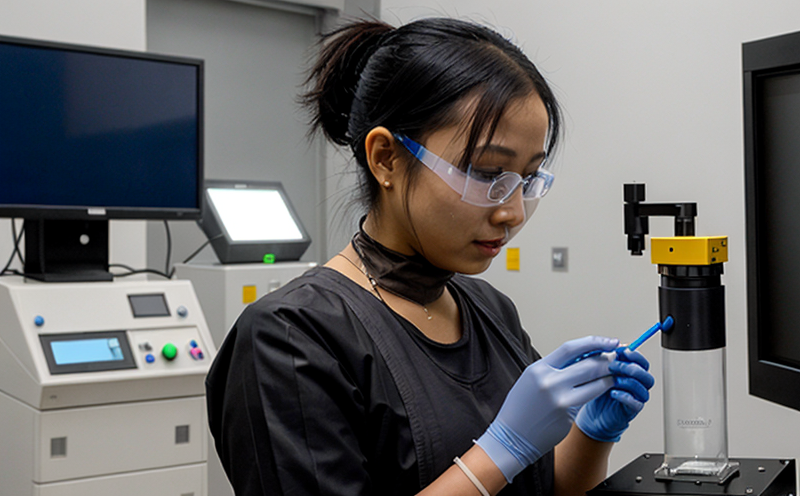ASTM E2859 Microscopy Imaging of Nanoparticles in Soil and Sediments
The ASTM E2859 standard provides a comprehensive approach to the microscopy imaging of nanoparticles present within soil and sediment samples. This service is crucial for understanding the behavior, distribution, and potential environmental impacts of nanomaterials. By employing advanced analytical techniques such as Transmission Electron Microscopy (TEM), Scanning Electron Microscopy (SEM), and Energy Dispersive X-ray Spectroscopy (EDX), this method allows for precise identification and characterization of nanoparticles down to the atomic level.
The process begins with thorough sample preparation, ensuring that the nanomaterials are accurately represented in the imaging. This includes dispersing the soil or sediment samples into a suitable medium compatible with microscopy analysis. The standard outlines specific protocols that ensure accurate representation of nanoparticle characteristics and their distribution within the matrix. Once prepared, the samples undergo detailed visualization using high-resolution microscopes.
The significance of this testing cannot be overstated in today’s world where nanotechnology is increasingly integrated into various industries including agriculture, manufacturing, and healthcare. Understanding how nanoparticles behave in natural environments can help mitigate risks associated with their release into ecosystems. Moreover, compliance with regulatory requirements necessitates accurate characterization techniques like those specified in ASTM E2859.
This service not only aids in meeting legal obligations but also supports research aimed at developing safer nanomaterials by providing insights into interaction mechanisms between nanoparticles and environmental components. The detailed documentation provided following the analysis serves as valuable reference material for further studies or implementation of preventive measures where necessary.
By adhering strictly to ASTM E2859 guidelines, our laboratory ensures reliable results that are both accurate and reproducible. Our team uses state-of-the-art equipment capable of capturing high-quality images essential for proper interpretation of data collected during the imaging process. With years of experience in environmental nanomaterials testing, we offer unparalleled expertise tailored specifically to meet your needs.
Understanding nanoparticle behavior within soil and sediment matrices is vital not only from an ecological perspective but also because these tiny particles can affect human health if they enter water supplies or air through improper disposal methods. Proper characterization helps identify potential risks early on so that appropriate actions can be taken to minimize harm.
| Applied Standards |
|---|
| ASTM E2859-16: Standard Practice for Microscopy Imaging of Nanoparticles in Soil and Sediments |
Why It Matters
The importance of ASTM E2859 cannot be overstated when it comes to the safe handling and disposal of nanomaterials. As these materials become more prevalent in our daily lives, understanding their impact on both humans and ecosystems becomes increasingly critical. Proper identification and characterization ensure that potential risks are recognized early enough for corrective action to be taken.
With growing concerns about environmental pollution due to nanoparticles released into air or water systems, accurate assessment through methods like those described by ASTM E2859 is essential. The ability to visualize these particles at such small scales allows scientists and engineers to better understand their properties and interactions with different materials. This knowledge can then be used to develop safer products or improve waste treatment processes.
In addition to regulatory compliance, this service also supports cutting-edge research into novel applications for nanotechnology. For instance, it enables investigations into how certain types of nanoparticles might enhance plant growth rates while simultaneously reducing the need for chemical fertilizers. Such findings could lead to significant advancements in sustainable agriculture practices worldwide.
Moreover, by providing detailed reports based on ASTM E2859 standards, our laboratory contributes valuable information towards establishing best practices across industries dealing with nanomaterials. This helps foster an environment where innovation is encouraged while maintaining high safety standards.
Applied Standards
The application of ASTM E2859 in environmental nanomaterials testing ensures consistency and reliability across various studies and applications. This standard provides clear instructions on sample preparation, imaging procedures, and data analysis techniques that are essential for obtaining accurate results.
- Sample Preparation: The method specifies the optimal conditions under which soil or sediment samples should be prepared before microscopy. These include drying times, grinding methods, and dispersing agents used to ensure nanoparticles remain intact throughout the process.
- Imaging Techniques: Detailed descriptions are provided for different types of microscopes that can be employed depending on the size and nature of the nanoparticles being studied. This includes both TEM and SEM configurations along with complementary EDX analysis.
- Data Analysis: Instructions outline how to interpret images obtained from microscopy, including identifying particle sizes, shapes, and compositions using software tools designed for this purpose.
The use of these standardized procedures guarantees that all participants in nanomaterials research follow consistent methods, leading to comparable datasets. This is particularly important when multiple laboratories are collaborating on projects or submitting results to regulatory agencies.
Why Choose This Test
- Precision: ASTM E2859 guarantees precise identification and measurement of nanoparticles, even down to the atomic scale. This level of accuracy is crucial for ensuring reliable data that can be used confidently in decision-making processes.
- Compliance: Compliance with this standard ensures adherence to international regulations regarding nanomaterials testing. Meeting these requirements helps avoid penalties and fosters trust among stakeholders.
- Reproducibility: The methodology outlined by ASTM E2859 allows for consistent results across different laboratories, making it easier to compare findings from various sources.
- Expertise: Our team of highly trained professionals brings extensive experience in environmental nanomaterials testing. Leveraging their expertise ensures that your samples receive the highest quality analysis possible.
- Advanced Equipment: Utilizing cutting-edge microscopy equipment enables us to capture high-resolution images necessary for detailed characterization of nanoparticles within soil and sediment matrices.
- Comprehensive Reports: Post-analysis, we provide comprehensive reports that summarize key findings along with recommendations for future studies or actions. These documents serve as important references for ongoing projects or compliance purposes.





